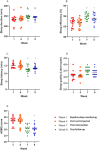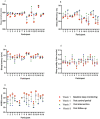The use of individualised, media-based sleep hygiene education for professional female footballers
- PMID: 39776218
- PMCID: PMC11706236
- DOI: 10.1002/ejsc.12247
The use of individualised, media-based sleep hygiene education for professional female footballers
Abstract
Sleep hygiene can be defined as practicing habits that facilitate sleep; poor sleep hygiene is common among elite athletes, and improving this can be one way to enhance sleep indices. Given the large inter-individual variability of sleep, there is a need for further investigation into individualised sleep hygiene for elite female athletes, with consideration for the practical application of the method. Using a self-controlled time series design with repeated measures, n = 16 professional female footballers completed a 9-week study during mid-season. Monitoring of sleep (actigraphy, self-report) occurred at week 1, 4, 7 and 9-a control period occurred at week 2 and 3, and a subsequent intervention period occurred at weeks 5 and 6. Based on baseline sleep monitoring, media-based messages were designed with the purpose of giving a singular sleep hygiene message; all participants received these individualised messages daily across the 2-week intervention period at a standardised time of 8.00 p.m., with the intention of them actioning the sleep hygiene point. One-way analysis of variance with repeated measures was conducted to assess the differences between control period, intervention period and follow-up for each measured variable. Significant differences were observed post-intervention for sleep efficiency (p < 0.001) and sleep latency (p < 0.001), whereas the athlete sleep behaviour questionnaire score significantly improved in the follow-up period (week 9) post intervention (p = 0.039). This is the first study to present this novel method of individualised sleep hygiene education for elite female athletes and is also the first study to demonstrate the use of sleep hygiene interventions to improve sleep factors for female athletes' mid-season. This demonstrates a promising, time-efficient approach to sleep hygiene education, with a potentially wide scope of application, as well as demonstrating there is indeed potential for elite female athletes to gain sleep improvements mid-season.
Keywords: health; recovery; relaxation; team sport.
© 2025 The Author(s). European Journal of Sport Science published by Wiley‐VCH GmbH on behalf of European College of Sport Science.
Conflict of interest statement
The authors declare no conflicts of interest.
Figures





References
-
- Adan, A. , and Almirall H.. 1991. “Horne and Östberg Morningness‐Eveningness Questionnaire: A Reduced Scale.” Personality and Individual Differences 12(3): 241–253. 10.1016/0191-8869(91)90110-w. - DOI
-
- Asih, F. R. , Pondaang M. F., and I’anah F. C.. 2024. “Education with Animation Video and Flyer Improving Pregnant Women Behavior of Sleep Hygiene: Which One More Effective?” Jurnal Kesehatan Masyarakat 19(3): 456–461. 10.15294/kemas.v19i3.45813. - DOI
-
- Bender, A. M. , Lambing K. A., and Singh M.. 2024. “Basics of Sleep Problems and Sleep Disorders for Athletes and Sport Professionals.” In Sleep and Sport, 63–71. Academic Press.
MeSH terms
LinkOut - more resources
Full Text Sources
Medical

